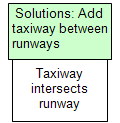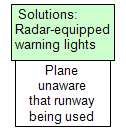During the overnight shift on November 5, 2005, two workers at a refinery in Delaware City, Delaware died from asphyxiation. Both workers had entered a confined space that was filled with nitrogen. We will use information from the Chemical Safety Board’s root cause analysis investigation to create a Cause Map. A thorough root cause analysis built as a Cause Map can capture all of the causes in a simple, intuitive format that fits on one page.
The first step in our analysis is to define the problem by filling out the outline. The outline contains the what, when, where and impact to the goals. The “what” is the problem; in this case two workers were asphyxiated. The when is the overnight shift of November 5, 2005, and the where is the hydrocracker reactor of a Delaware City refinery. The workers were apparently attempting to retrieve dropped tape.
Because two workers were killed, there was an impact to the safety goal. There may have been impacts to other goals as well, but the loss of life makes other impacts less significant.
Once the outline is completed, we use the impacted goal to begin the Cause Map. We begin with the impacted goal and ask ‘why’ questions. A good way to begin is using the “5-why” technique. Begin with the impacted goal and ask “why” 5 times. This will start the Cause Map. For this incidence: the safety goal was impacted. Why? Because two workers died. Why? Because they were asphyxiated. Why? Because they entered a confined space. Why? They were attempting to retrieve lost tape. Why? Because the tape was left in the reactor.
From the “5-why” Cause Map we can add more detail to the root cause analysis. Additional causes can be added before, after and between the causes on the 5-why map. For example, the workers were asphyxiated because they entered the confined space AND the space was filled with nitrogen. The space being filled with nitrogen is added as an additional cause of asphyxiation, and is joined with “AND” because both causes had to be present for the asphyxiation to occur.
Even more detail can be added to this Cause Map as the root cause analysis continues. As with any investigation the level of detail in the analysis is based on the impact of the incident on the organization’s overall goals. The outline, “5-why” Cause Map and detailed Cause Map can be seen by clicking “Download PDF” above.





